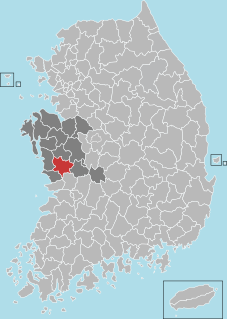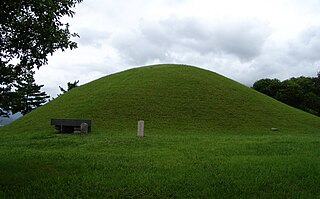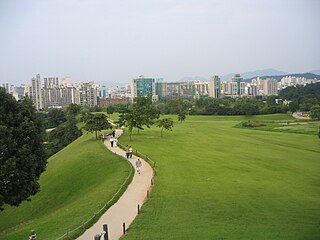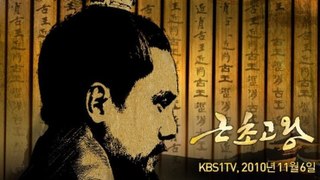
Korea has a variety of fortresses, including sanseong (mountain fortress), jinseong (camp fortress), and eupseong (city fortress). This is a list of notable fortresses.

Korea has a variety of fortresses, including sanseong (mountain fortress), jinseong (camp fortress), and eupseong (city fortress). This is a list of notable fortresses.
| Revised Romanization | Hangul | Hanja | Location | Type | Comments |
|---|---|---|---|---|---|
| Fortress Wall of Seoul | 서울 한양도성 | 서울 漢陽都城 | Seoul | Defensive wall | Capital of Joseon |
| Namhansanseong | 남한산성 | 南漢山城 | Gyeonggi | Hill fort | |
| Bukhansanseong | 북한산성 | 北漢山城 | Gyeonggi | Hill fort | |
| Hwaseong Fortress | 수원 화성 | 水原 華城 | Gyeonggi | Defensive wall | |
| Suwon goeub fortress | 수원고읍성 | 水原古邑城 | Gyeonggi | Defensive wall | |
| Haengju mountain fortress | 행주산성 | 幸州山城 | Gyeonggi | Hill fort | See Siege of Haengju |
| Fortress site of Jwasuyeong | 경상좌수영성지 | 慶尙左水營城址 | Gyeongsang (Busan) | Defensive wall | See Siege of Busan |
| Geumjeong Fortress | 금정산성 | 金井山城 | Gyeongsang (Busan) | Defensive wall | See Siege of Dongnae |
| Dongnaeeupseong fortress | 동래읍성지 | 東萊邑城址 | Gyeongsang (Busan) | Defensive wall | See Siege of Dongnae |
| Dadaepo fortress | 다대포성 | 多大浦城 | Gyeongsang (Busan) | Defensive wall | See Battle of Tadaejin |
| Busanjinseong | 부산진성 | 釜山鎭城 | Gyeongsang (Busan) | Defensive wall | See Siege of Busan |
| Jinju fortress | 진주성 | 晉州城 | Gyeongsang | Defensive wall | See Siege of Jinju (1592) and Siege of Jinju (1593) |
| Namwon fortress | 남원성 | 南原城 | Jeolla | Defensive wall | See Siege of Namwon |
| Yeongwon mountain fortress | 영원산성 | 領願山城 | Gangwon | Hill fort | See Gangwon Campaign |
Ungjin, also known as Gomanaru is a former city on the Korean Peninsula. It was located in modern-day Gongju, South Chungcheong province, South Korea. It was the capital of Baekje from AD 475 to 538, during a period when Baekje was under threat from Goguryeo, the previous capital of Wiryeseong having been overrun. In 538, King Seong moved the capital to Sabi. Ungjin is now known as Gongju.

Buyeo County (Buyeo-gun) is a county in South Chungcheong Province, South Korea. Buyeo-eup, the county's capital, was the site of the capital of Baekje from 538-660 AD, during which it was called Sabi Fortress.
Daru of Baekje was the second king of Baekje, one of the Three Kingdoms of Korea.
Chogo of Baekje was the fifth king of Baekje, one of the Three Kingdoms of Korea.
Uija of Baekje was the 31st and final ruler of Baekje, one of the Three Kingdoms of Korea. His reign ended when Baekje was conquered by an alliance of the rival Korean kingdom Silla and China's Tang dynasty.
Wideok of Baekje (525–598) was the 27th king of Baekje, one of the Three Kingdoms of Korea. He was the eldest son of King Seong, and rose to the throne upon his father's death.
Gaero of Baekje was the 21st king of Baekje, one of the Three Kingdoms of Korea. He was the eldest son of the 20th king Biyu. He died in battle as Baekje's capital in the present-day Seoul region fell to the northern rival kingdom Goguryeo.
Munju of Baekje was the 22nd king of Baekje, one of the Three Kingdoms of Korea. His reign saw considerable disunity within Baekje following the fall of its capital in present-day Seoul.
Dongseong of Baekje was the 24th king of Baekje, one of the Three Kingdoms of Korea.
Buyeo Yung (615–682) was the eldest son of King Uija, the last king of Baekje. He was appointed crown prince in 644, and would have been the kingdom's 32nd ruler. He is known as the progenitor of Buyeo Seo Clan where he changed his surname to Seo.

Earthen Fortification in Pungnap-dong, Seoul is a flat earthen wall built at the edge of the Han River in Korea. It has a circumference of 3.5 km. It is located in modern-day Pungnap-dong, Songpa-gu, Seoul. It used to be included in the neighboring city of Gwangju. It has a long oval shape, spreading to north and south, and leaning slightly toward the east. Based on research conducted during the Japanese occupation, it has been speculated that Pungnap Toseong was Hanam Wiryeseong, the first capital of Baekje.

Chumo, posthumously Chumo the Holy, was the founding monarch of the kingdom of Goguryeo, and was worshipped as a god-King by people of Goguryeo. Chumo was originally a Buyeo slang for an excellent archer, which became his name later. He was commonly recorded as Jumong by various Chinese literatures including history books written by Northern Qi and Tang—the name became dominant in future writings including Samguk Sagi and Samguk Yusa. Chumo's title was changed to Dongmyeong the Holy, literally translated to the Bright Holy King of the East, at some point of time prior to compilation of Samguk Sagi (1145). His other names include Chumong, Jungmo, Nakamu, or Tomo. In Samguk Sagi, he was recorded as Jumong with the surname Go, and was also known as Junghae or Sanghae.

Jinpyeong of Silla was the 26th king of the Silla Dynasty, one of the Three Kingdoms of Korea. King Jinpyeong followed in the footsteps of his predecessor, King Jinji, by reorganizing the central ruling system of Silla. Upon the onset of a multitude of conflicts between Baekje and Goguryeo, he sent emissaries to improve relations and strengthen ties between Silla and the Chinese dynasties Sui and Tang. He is also known for his promotion of Buddhism as a spiritual guide for the kingdom and encouraging Buddhist teachings.

Cheolli Jangseong in Korean history usually refers to the 11th-century northern defense structure built during the Goryeo dynasty in present-day North Korea, though it also refers to a 7th-century network of military garrisons in present-day Northeast China, built by Goguryeo, one of the Three Kingdoms of Korea.

Mongchontoseong Earthen Fortification is an ancient earthen rampart dating from the Baekje kingdom. It appears to have played the same role in defending the region the fortifications constructed on Mt. Acha. The fortification walls are estimated to have been about 2.7 kilometres in length and approximately 6 to 7 metres high. The fortifications of Mongchon Toseong had two unique features: a palisade atop the wall and a moat surrounding its base. They are part of Wiryeseong with Pungnaptoseong. It is located what is now in the Olympic Park of Seoul, South Korea. During the 1988 Summer Olympics, the running portion of the modern pentathlon event were hosted there. A number of important excavations of the site were conducted prior to the construction of the nearby Olympic Park.

The King of Legend is a 2010 South Korean historical drama based on King Geunchogo of Baekje. Besides historical information from Samguk Sagi and Samguk Yusa, it was also inspired by a novel written by Lee Munyeol, a renowned Korean writer. The drama aired on KBS1 in Korea, and internationally through KBS World.

The Fortress Wall of Seoul, or literally the Seoul City Wall is a series of walls made of stone, wood and other materials, built to protect the city of Seoul against invaders. The wall was first built in 1396 to defend and show the boundaries of the city, surrounding Hanyang in the Joseon Dynasty. At that time, it was called Hansung. The wall stretches 18.6 km along the ridge of Seoul's four inner mountains, Bugaksan, Inwangsan, Naksan and Namsan. At present, a 12-km section of the wall is designated as Historic Site No. 10 (1963) and is protected accordingly, along with the gates, water gates, and signal fire mounds. The northern, eastern, and southern sections of Mt.Nam walls have undergone extensive restoration work, having sustained damage or been entirely destroyed during Japanese imperial rule (1910–1945).
The Ungjin Commandery was an administrative division of the Chinese Tang dynasty that existed between 660 and 671 on the Korean Peninsula. It was created in place of Baekje in present-day Chungcheong Province after its defeat by a joint Silla-Tang alliance. The Tang dynasty incorporated the Ungjin Commandery into the Protectorate General to Pacify the East and furthermore proposed to Munmu of Silla to set up the Great Commandery of Gyerim in place of Silla. Those political organizations renamed the newly conquered areas under the Jimi system.
The Great Eight Families were eight noble families of Baekje, one of the Three Kingdoms of Korea. They were the most powerful of the noble families and had been comrades in arms with the founding monarch Onjo of Baekje. They reached the pinnacle of their power during the Sabi, recorded in Chinese records such as Tongdian.